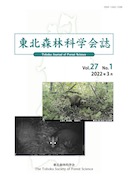All issues

Volume 27 (2022)
- Issue 1 Pages 1-
Current issue
Displaying 1-2 of 2 articles from this issue
- |<
- <
- 1
- >
- >|
Original Articale
-
Nami Kumagai, Masayuki SaitoArticle type: Original Article
2022 Volume 27 Issue 1 Pages 1-10
Published: March 31, 2022
Released on J-STAGE: April 27, 2023
JOURNAL FREE ACCESSIn this study, we investigated seasonal changes in raccoon dog diet in a cool-temperate forest on the Sea of Japan side of the Tohoku region (where few studies have been conducted) by fecal analysis. From December 2018 to November 2019, we collected in total 126 feces samples from 20 raccoon dog latrine sites near Mt. Takadate, in the Shonai region of Yamagata Prefecture. The diet composition as indicated by fecal contents was expressed in terms of frequency of occurrence, and relative frequency of occurrence of each food category. To reveal seasonal changes in food item composition, and breadth of the raccoon dogs’ trophic niche, we conducted principal coordinate analysis (PCoA), and calculated their dietary niche width. Fecal analysis showed that insects, seeds, and fruits were abundantly consumed throughout the year. The main fruits consumed in this study area were Actinidia arguta, Malus tchonoskii, Ilex macropoda, and Hovenia dulcis. The frequency of their consumption displayed seasonal variation. PCoA and dietary niche breadth analyses showed that seasonal changes in diet composition were most pronounced from winter to spring, with diet composition becoming more diverse in spring. Our results are generally consistent with those of previous studies. Raccoon dogs in this study area use foods in their habitat according to availability, as in other regions.View full abstractDownload PDF (4258K)
Report
-
Ryoga Watabe, Masayuki SaitoArticle type: Report
2022 Volume 27 Issue 1 Pages 11-17
Published: March 31, 2022
Released on J-STAGE: April 27, 2023
JOURNAL FREE ACCESS
- |<
- <
- 1
- >
- >|